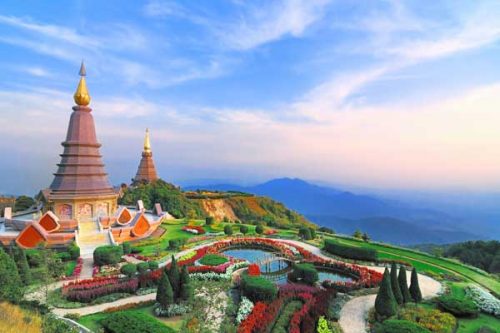
At 2,565m, Doi Inthanon is the highest mountain in Thailand and its surrounding areas are designated as the Doi Inthanon National Park. The park itself lies roughly 90 minutes’ drive southwest of Chiang Mai and is popular for its magnificent waterfalls, flora and excellent views. You can drive all the way to the top, where stately chedis have been erected in honour of the present King and Queen of Thailand. The climate up at the top is almost alpine and cool at all times of the year, with sub-zero (Celsius) temperatures in winter.
The best way to explore Doi Inthanon National Park is by rental car or bike. If you don’t want to drive yourself, you can hire a minivan to drive you there, but this option only makes sense if you have a group of people to defray the cost. The low budget option, and an adventurous one, would be to take a Songthaew (red pick-up truck) from Chiang Mai to Chom Thong and then catch another songthaew up to Doi Inthanon. Many songthaews ply the roads through the national park and it shouldn’t be difficult to get a ride in either direction.
On the way to the peak, driving up from Chom Thong, there are numerous waterfalls on both sides of the road to explore. The most spectacular may be Mae Yai Falls, which drop 100m in cascade form. Mae Klang Waterfall is the most accessible, found right beside the park entrance at the bottom, and is hugely popular with picnicking Thais on weekends. It’s certainly worth stopping for.
Halfway up is Wachiratan waterfall, which plunges over a 40m drop and cascades down through some suitable swimming pools. The final waterfall, Siriphum, can be seen from the road near the ranger station and campsite and is also a tall wisp of white water and usually less busy. However, the water level varies greatly from dry to rainy season.
There is also a Karen weaving village, Ban Pha Mon, which is well worth a visit for textiles lovers. For those bird-watching enthusiasts, there are several signs for bird-watching sites before you get to the ranger station or park headquarters, along with plenty of well-signposted walking trails to enjoy as well.
Right by the ranger station is the Royal Project, which is a centre for the development of highland agriculture alternatives. Here, visitors can stroll around the beautiful flower gardens and learn about the agricultural development activities of this programme, which was introduced as an alternative to poppy cultivation.
Just up the road from the ranger station is a Hmong market, which sells produce from the Royal Project and Hmong villages around Mae Chaem. Actual Hmong hill tribe people live there and it is worth a stopover to see and photograph their colourfully embroidered clothing.
On the top of Doi Inthanon are the Royal Chedis, from where you can have sweeping views of the valley below, especially to Mae Chaem. However, cloud cover is the norm and visibility may be poor. The chedis commemorate the 60th birthdays of the King and Queen respectively and contain Buddha images and tiled murals. There is a good photo opportunity at the peak in the form of a giant sign proclaiming ‘The highest point in Thailand’.
There are not many options for overnight stays in the national park itself. Either you can rent a chalet at the ranger station or use the campsite (a little farther back down the main road; turn left at the signs). However, advance booking is advised during high season as Doi Inthanon is a popular destination for both Thais and foreigners. For those wanting more modern comforts, there are plenty of guesthouses and resort-type guesthouses in Chom Thong, Hot and Mae Chaem. The most practical and best choices are three resorts located down a lane well signposted on the right of the main road into the park just before it ascends the mountain.
